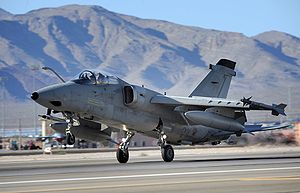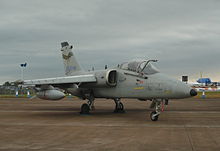AMX International AMX Video - Italian overview
|
|
AMX International AMX
AMX

Role: Attack aircraft
Manufacturer: AMX International
First flight: 15 May 1984
Introduced: 1989
Status: Active service
Primary users: Italian Air Force
Brazilian Air Force
Produced: 1986-1999
Number built: ~ 200
The AMX International AMX is a ground-attack aircraft for battlefield interdiction, close air support and reconnaissance missions. It is built by AMX International, an Italian-Brazilian joint venture, and is designated the A-1 by the Brazilian Air Force.
The AMX is capable of operating at high subsonic speed and low altitude, by day or night, and if necessary, from bases with poorly equipped or damaged runways. Low IR signature and reduced radar equivalent cross-section help prevent detection, while low vulnerability of structure and systems aid survivability. Integrated ECM, air-to-air missiles and nose-mounted guns provide self-defence capabilities.
Development
In 1977, the Italian Air Force issued a requirement for a strike fighter to replace its Aeritalia G.91 and some of its F-104 Starfighters. Rather than competing for the contract, Aeritalia (now Alenia Aeronautica) and Aermacchi agreed to make a joint proposal, as both firms had been considering the development of a similar class of aircraft for some years. Aermacchi, for example, had worked on a design study for a light ground attack aircraft, designated MB-340, in the early 1970s. Development work began in April 1978.
In July 1981, the Italian and Brazilian governments agreed on joint requirements for the aircraft, and Embraer was invited to join the partnership.
The first prototype flew on 15 May 1984. Although it was lost on its fifth flight (killing its pilot), the test programme progressed reasonably smoothly otherwise. Production started by mid-1986, with the first examples delivered to the Italian and Brazilian air forces in 1989. Since then, some 200 AMXs have been built.
Italian AMX squadrons flew 252 combat sorties over Kosovo as part of Operation Allied Force, without a single loss.
Operational history
Italian AMX aircraft were used in 1999 in the Kosovo war. Instead of using unguided or more traditional laser-guided bombs, the Italian Air Force used dozens of Mk 82 bombs fitted with Israeli guidance kits ( "Opher"), effectively converting the "dumb" bombs into an infrared-guided bomb.
In 2005, the Italian Air Force launched an upgrade programme (ACOL Aggionamento Capacitx Operative e Logistiche - Operational and Logistical Capacity Upgrade) for 55 of its AMXs,, adding a new laser INS, new cockpit displays and allowing the aircraft to drop Joint Direct Attack Munition guided bombs.
Since fall 2009, four Italian AMX are located in Afghanistan, replacing the same number of Italian Tornado IDS in the recce role.
Variants
AMX-T
In 1986, development of a two-seat advanced trainer variant was undertaken. This was intended to provide trainee pilots with experience on fast jets, while still retaining the single-seater's attack capabilities. The AMX-T first flew in 1990 and equips both the Italian and Brazilian air forces.
AMX-ATA
The AMX Advanced Trainer Attack (AMX-ATA) is a new AMX two-seater multi-mission attack fighter developed for combat roles and advanced training. The AMX-ATA incorporates new sensors, a forward-looking infrared helmet-mounted display, a new multi-mode radar for air-to-air and air-to-surface capability, and new weapons systems including anti-ship missiles and medium-range missiles. The Venezuelan Air Force ordered eight AMX-ATA in 1999 for the advanced trainer and attack aircraft role, but the U.S. Congress vetoed the sale because the aircraft systems include U.S. technology.
AMX-R (RA-1)
The AMX for reconnaissance, used by the Brazilian Air Force, with a reconnaissance pallet.
Operators

Picture - AMX at RIAT 2010.
Brazil: Brazilian Air Force. Operates 55 AMXs.
1 Esquadrx£o/16 Grupo de Aviax§x£o Esquadrx£o Adelphi
1 Esquadrx£o/10 Grupo de Aviax§x£o
3 Esquadrx£o/10 Grupo de aviax§x£o
Italy: Italian Air Force. four prototypes, 110 one-seaters and 26 two-seaters.
13 Gruppo/32 Stormo
14 Gruppo/2 Stormo (disbanded)
28 Gruppo/3 Stormo (disbanded)
101 Gruppo/32 Stormo
103 Gruppo/51 Stormo
132 Gruppo/51 Stormo

Picture - AMX Brazilian Air Force.
Specifications (AMX)
Data from Aeronaves
General characteristics
Crew: 1
Length: 13.23 m (43 ft 5 in)
Wingspan: 8.87 m (29 ft 1 in)
Height: 4.55 m (14 ft 11 in)
Wing area: 21 m² (226 ft²)
Empty weight: 6,730 kg (14,840 lb)
Loaded weight: 10,750 kg (23,700 lb)
Max takeoff weight: 13,000 kg (28,700 lb)
Powerplant: 1x— Rolls-Royce Spey 807 turbofan, 49 kN (11,000 lbf)
Performance
Maximum speed: 1,160 km/h (626 knots, 721 mph)
Cruise speed: 950 km/h (510 knots, 590 mph)
Range: 3,330 km (1,800 nm, 2,070 mi)
Service ceiling: 13,000 m (43,000 ft)
Rate of climb: 52 m/s (10,000 ft/min)
Wing loading: 512 kg/m² (105 lb/ft²)
Thrust/weight: 0.47
Armament
Guns:
1x— 20 mm (0.787 in) M61 Vulcan 6-barreled gatling cannon (Italian aircraft) or
2x— 30 mm (1.18 in) DEFA 544 cannon (Brazilian aircraft)
Missiles: 2x— AIM-9 Sidewinders or MAA-1 Piranha carried on wingtip rails
Bombs: 3,800 kg (8,380 lb) on 5 external hardpoints, including general-purpose and laser-guided bombs, air-to-ground missiles, and rockets
Comparable aircraft
BAE Hawk
KAI T-50 Golden Eagle
Soko J-22 Orao
Braybrook, Roy. "Assessing the AMX". Air International, June 1989, Vol 36 No 6. Bromley, UK:Fine Scroll. ISSN 0306-5634. pp. 267-278.
Niccoli, Ricardo. "AMX: Upgraded and Ready for Combat". Air International, November 2009, Vol 77 No 5. Stamford, UK:Key Publishing. ISSN 0306-5634. pp. 42-45.
AMX International AMX Pictures and AMX International AMX for Sale.
Living Warbirds: The best warbirds DVD series.
Source: WikiPedia